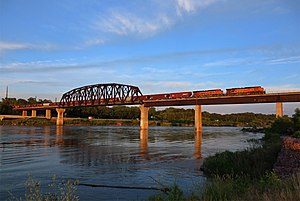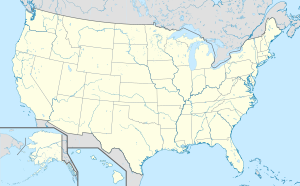Sioux City Bridge
Coordinates: 42 ° 28 ′ 29 " N , 96 ° 23 ′ 7" W.
| Sioux City Bridge | ||
|---|---|---|
| A BNSF grain train on the bridge in 2017 | ||
| use | Railway bridge | |
| Crossing of | Missouri River | |
| place | South Sioux City ( Nebraska ) and Sioux City ( Iowa ) | |
| Entertained by | BNSF Railway | |
| construction | Truss bridge | |
| overall length | approx. 460 m | |
| Longest span | approx. 130 m | |
| opening | 1888, 1981 | |
| planner |
Morison & Corthell (1888) Burlington Northern (1981) |
|
| location | ||
|
|
||
The Sioux City Bridge , also Sioux City Railroad Bridge , is a single-track railroad bridge over the Missouri River between South Sioux City in Nebraska and Sioux City in Iowa . It goes back to one of the first bridges over the Missouri from 1888, which was built by George S. Morison for the Chicago, St. Paul, Minneapolis and Omaha Railway (Omaha Road) . The Chicago and North Western Railway (C & NW) integrated as a longtime principal shareholder , the Omaha Road1972 final and gave up the obsolete bridge in favor of a new construction by the Burlington Northern Railroad (BN) in 1981. The BN had route rights over the old bridge and was its main user at the time. As compensation, C&NW received route rights over the new bridge, which are now owned by the Union Pacific Railroad . The BN merged in 1995 to form the BNSF Railway , which is now the operator of the bridge.
First bridge in 1888
The city of Sioux City developed into a railway junction with the expanding railroad companies in North America at the end of the 19th century and recorded rapid growth; the population was around 4,000 around 1870 and almost 38,000 in 1890. In contrast to other cities on the Missouri such as Kansas City , Bismarck or Blair , Sioux City did not have a railroad bridge over the river in the mid-1880s. Businessmen from Boston secured rights to build a bridge through the Sioux City Bridge Company as early as 1876, but it was not until the beginning of 1885 that the bridge engineer George S. Morison was commissioned with the first planning. However, it took another two years before construction work began, as the project was not accelerated until the Chicago, St. Paul, Minneapolis and Omaha Railway (Omaha Road) took over the Sioux City Bridge Company in May 1887. It was to be Morison's sixth bridge over the Missouri, where he worked in Sioux City with Elmer Lawrence Corthell as Morison & Corthell (1887-1889).
The single - track truss bridge built from the summer of 1887 consisted of four 122-meter-long Whipple truss girders with an underlying track (English whipple truss , after the inventor Squire Whipple , 1804-1888) and a short girder bridge on the eastern Iowa side. The bridge rested on five stone pillars, with the river piers being anchored in the river bed by means of caissons at a depth of over 20 meters; the total height was about 44 meters. A special feature of the superstructure was the almost exclusive use of the new building material steel , which replaced the wrought iron that had been common up until then . The construction of the steel construction was completed on November 8, 1888 and the first train passed the bridge on November 26, 1888.
Second bridge 1981
The Chicago and North Western Railway (C&NW) had been the main shareholder of Omaha Road since 1882 and finally took it over completely in 1972. The aging bridge was mainly only used by the Burlington Northern Railroad (BN) in the 1970s , which owned the route rights with C&NW and was planning a new construction with a higher load capacity. In exchange for route rights over the new bridge, C&NW finally gave up their old bridge. The BN built a modern railway bridge in the immediate vicinity by the end of 1981 and had the old one demolished later. The route rights of the C&NW are now owned by the Union Pacific Railroad and the BN merged in 1995 to form the BNSF Railway , which is now the operator of the bridge.
The central element of today's bridge is an approximately 130-meter-bearing truss with a curved upper chord and track below, which is designed as a strut truss with posts (Warren truss) . The steel girder is flanked by several girder bridges with solid wall girders ; the total length is about 460 meters. The bridge is supported by reinforced concrete pillars , with the two central river pillars having cantilever arms to accommodate the supports of the truss.
Web links
- Sioux City Railroad Bridge. John A. Weeks III.
- BNSF - Sioux City Bridge. Bridgehunter.
- Sioux City Bridge, Spanning the Missouri River, Sioux City, Woodbury County, IA. Historic American Engineering Record, HAER IA-96.
- Ron Minor: Some finds in a yellow box. RailfanRails blog, February 1, 2014 (photo of the old and new bridge from 1981).
literature
- Clayton B. Fraser: Nebraska City Bridge. Historic American Engineering Record, HAER No. NE-2, Denver, Colorado 1986, pp. 160-178.
- George S. Morison: The Sioux City Bridge: A Report to Marvin Hughitt, President of the Sioux City Bridge Company. Chicago 1891.
Individual evidence
- ^ Rudolph Daniels: Sioux City Railroads. Arcadia Publishing, 2008, ISBN 978-0-7385-5222-4 , pp. 7-9.
- ^ A b Clayton B. Fraser: Nebraska City Bridge. Historic American Engineering Record, HAER No. NE-2, Denver, Colorado 1986, pp. 160-178.
- ^ George S. Morison: The Sioux City Bridge: A Report to Marvin Hughitt, President of the Sioux City Bridge Company. Chicago 1891, pp. 3-7, plate 4 and 6th
- ^ Rudolph Daniels: Sioux City Railroads. Arcadia Publishing, 2008, ISBN 978-0-7385-5222-4 , p. 115.
- ^ A b Sioux City Railroad Bridge. John A. Weeks III. Retrieved July 31, 2018.



